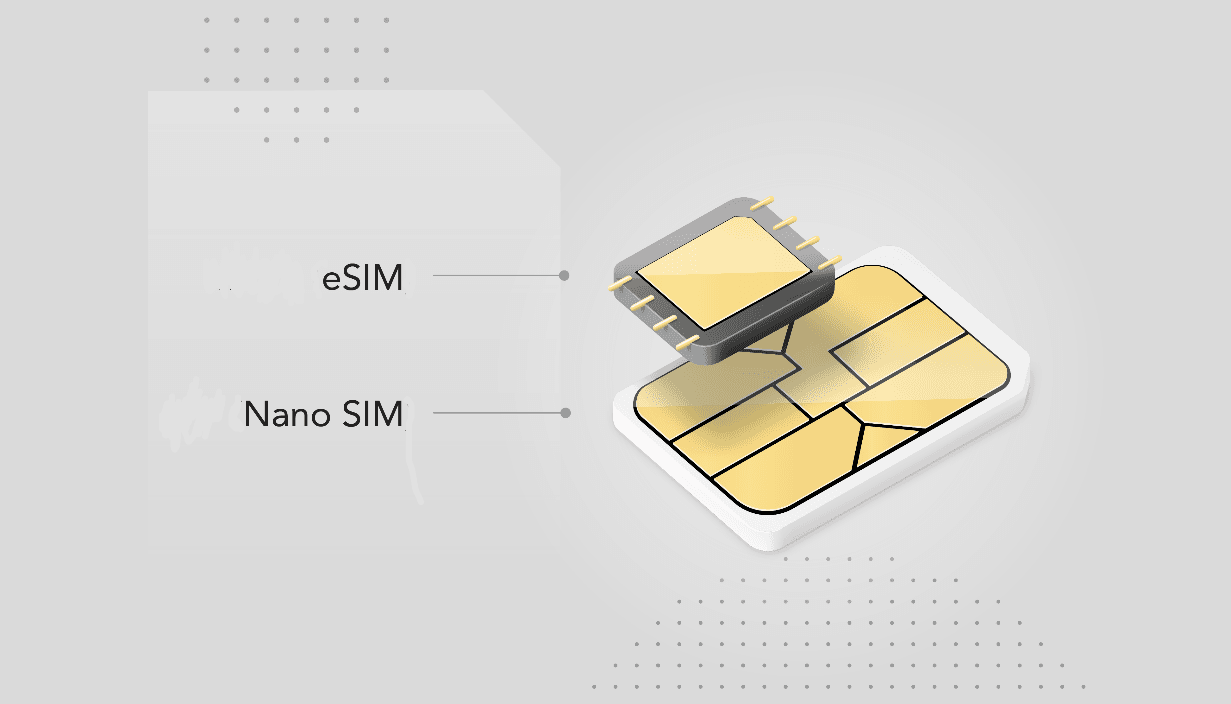In today's rapidly evolving technological landscape, the humble SIM card has undergone a remarkable transformation. From its early days as a credit card-sized Subscriber Identity Module (SIM), it has evolved into a digital marvel that's embedded into your device - the eSIM. This article traces the journey of SIM cards, culminating in the rise of eSIM technology.
October 17, 2023
5 minutes read
The Evolution of SIM Cards: From Traditional to eSIM Technology

The History of the SIM Card
Back in 1983, when the world's first mobile phone, the Motorola DynaTAC 8000X, was introduced, it didn't use SIM cards. This hefty device weighed a kilogram and carried a staggering $4,000 price tag. Fast forward to the early '90s, the Global System for Mobile Communications (GSM) emerged, marking the advent of the second generation (2G) of cellular networks. GSM allowed communication companies to identify a phone's owner, but the SIM card had yet to take its modern form.
How SIM Cards Have Evolved
- The First SIM Card (1991): The German company Giesecke+Devrient introduced the first SIM card, roughly the size of a credit card, and called it a Subscriber Identity Module (SIM)
- Mini SIM (1996): The mini SIM made its debut, and inserting it was a simple task, often requiring you to open the battery-saving area on your phone's back
- Micro SIM (2010): With the launch of the iPhone 4, the micro SIM was born, further reducing the SIM's physical footprint
- Nano SIM (2012): The nano SIM followed, and it's still the standard for most modern smartphones
- eSIM: Enter the eSIM, which integrates SIM functionality into your device, allowing you to download eSIM plans for instant connectivity without physical cards.
Dual SIM Technology
For those who demand even greater versatility, Dual SIM devices have become increasingly popular. They permit the simultaneous use of multiple SIMs and eSIMs, making them an attractive choice for both business and travel.
In 2018, Apple made a significant move by introducing Dual SIM capabilities with the iPhone XR. This trend has continued with later Apple devices, which offer support for both traditional SIMs and eSIMs, giving users the flexibility to switch between multiple numbers as needed.
What Is a Digital SIM (eSIM)?
The introduction of the eSIM, also known as an embedded SIM or digital SIM, has revolutionised the realm of communication. An eSIM is a SIM card embedded within your device. Instead of purchasing a physical SIM card and manually inserting it, eSIMs can be activated digitally.
The primary distinction between eSIMs and traditional SIMs is the ability to download an eSIM for instant connectivity without any physical handling. This innovation streamlines the process and allows for greater flexibility and convenience.
The Evolution of the eSIM
The journey of the eSIM has been marked by significant milestones:
- 2016: Samsung introduced eSIM support with its Samsung Gear S2 smartwatch
- 2017: Google launched its Pixel 2 smartphone with Google Fi eSIM technology, while Apple incorporated eSIM into the Apple Watch Series 3
- 2018: Microsoft announced eSIM support for the Surface Pro LTE. Google introduced eSIM-enabled smartphones (Pixel 3 and Pixel 3 XL), and Apple launched the iPhone XS, iPhone XS Max, and iPhone XR with eSIM support
- 2019: Microsoft announced eSIM support for the Surface Pro LTE, and Google expanded its eSIM-compatible lineup with the Pixel 3a and Pixel 3 XL
- 2020: Motorola launched the Razr smartphone, exclusively supporting eSIMs
- 2022: Apple unveiled eSIM-only iPhones in the United States with the release of the iPhone 14, marking a significant shift in the smartphone industry.
Where Can I Get an eSIM?
For those seeking eSIM solutions, Telesim is an excellent choice. eSIMs offer a convenient way to stay connected, especially for travellers. Telesim provides a vast selection of eSIMs available for more than 200 countries and regions worldwide. Installing an eSIM is a straightforward process:
- Download the Telesim app.
- Choose your destination and the desired eSIM package.
- Install the eSIM.
- Follow the provided instructions to activate your eSIM.
Local or Global eSIMs
With Telesim, you can choose from local or global eSIMs based on your travel needs. Opt for global eSIMs for journeys spanning multiple countries and continents, or regional eSIMs tailored to specific regions, including Asia, Africa, Latin America, Europe, the Middle East, North Africa, and the Caribbean Islands.
The Future of the SIM Card
The evolution of SIM cards suggests a future where traditional physical SIMs may become obsolete, gradually replaced by eSIMs. This transformation echoes broader technological trends where physical mediums, such as DVDs and mail, have been succeeded by virtual alternatives like streaming services and email.
Several factors indicate that eSIMs are here to stay. Their convenience, affordability, and eco-friendly approach to connectivity make them an attractive choice. Apple's decision to release eSIM-only iPhone 14 models in the U.S. underscores the industry's shift away from traditional SIM cards, raising the possibility that eSIMs will become the standard for future smartphones.
As technology continues to advance, it's likely that worldwide eSIMs will play a central role in shaping the future of mobile connectivity. If you're considering embracing this digital revolution, you can explore a wide range of eSIM options through Telesim, ensuring you stay connected wherever your travels may take you.
Try Telesim today
Download our app and get access to over 130 eSIMs plans at the most affordable, local rates from around the world.